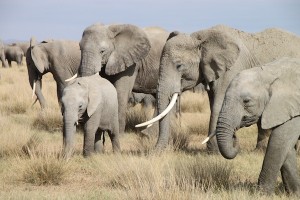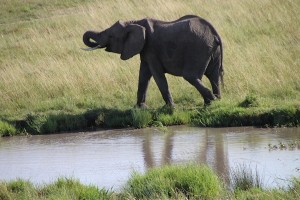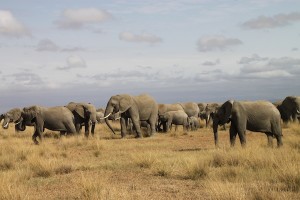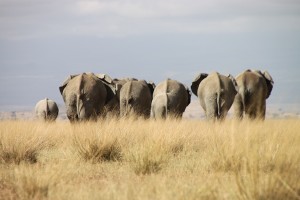I have a foster elephant, and her name is Kamok. Actually, quite a few people are foster “parents” to the same elephant.
This youngster, born in September 2013 in Kenya, was orphaned at birth (natural causes, it says on her paperwork). David Sheldrick Wildlife Trust’s orphanage for elephants and rhinos, located in Nairobi National Park, took her in.
She is among nearly two dozen young elephants at the orphanage available for fostering, a program that engages animal lovers at a personal level and helps fund their care. A couple of rhinos also can be fostered.

One of the orphaned elephants at David Sheldrick Wildlife Trust’s orphanage for elephants and rhinos runs to a feeding stall where he knows he will be bottle fed his evening milk.

Maxwell, the abandoned and blind rhino, makes himself available for attentions from his human visitors.
I visited the orphanage on the last day of a June 2014 press trip to Kenya.
During the trip, elephants got a lot of our attention, in part because our itinerary also included Amboseli National Park and the private Kitirua Conservancy that abuts it.
The Amboseli area is noted for its large elephant herds, but those herds are only large compared with other areas, not with herds of the past.
Our driver/guide at Amboseli, Joseph, passed along interesting trivia about elephants and frightening information about their fate, past, present and possibly future.
Starting with the fun factoids, he said the relative lengths of an elephant’s tusks indicate which tusk is most used, i.e., a shorter left tusk means the elephant is essentially left-handed.
The elephant’s trunk has 65,000 muscles and 3,000 nerve endings.
As for their fabled memories, Joseph said elephants don’t forget the scents of other animals or humans. He said you could blow a few times into the trunk of a baby, and the baby will remember you decades later.
Separately, we were told elephants have six sets of teeth in a lifetime, each good for a decade, after which they cannot live much longer.
In the 1960s, Amboseli National Park was host to 40,000 to 45,000 elephants, but now the park is down to around 1,600, Joseph said. Poaching is the major problem, but not in Amboseli itself, where the elephants benefit from 24-hour monitoring.
The problem, Joseph said, is that the elephants, which require 600 pounds of food daily per adult, must move around to eat, and that includes crossing into Tanzania, where licensed game hunting is legal. Poachers take advantage of that, he said.
Although continued severe drops in elephant numbers could render them extinct in a decade, Joseph said he is hopeful that “international intervention” will be effective enough that the elephant population will actually grow in the next 10 to 15 years.
And, by the way, another guide, Duncan, said the Big Five, meaning the large species tourists traditionally most want to see, originated as hunters’ top targets: the lions and leopards for their skins; rhinos for their horns; elephants for their tusks, and buffalo because they are so dangerous.
During our game viewing on Kitirua Conservancy, Joseph drove into the middle of a large elephant herd and we could get great close-in photos of very young elephants and others, plus one youngish male that was very curious about our vehicle. He moved his trunk across our windshield, probably checking for a memorable scent!
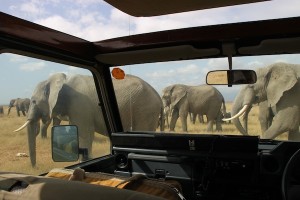
Elephants mill around our four-wheel drive on the Kitirua Conservancy, which is adjacent to Amboseli National Park in southern Kenya.
Our guides said the animals see our vehicles, and even our tents, as big boxes, and these “boxes” don’t have odors that frighten them.
Visiting the orphanage was a chance to get even closer. We watched 16 elephants race to stalls for their evening feeding. They are bottle fed milk, then given tree branches to work over. (The youngest, including my Kamok, were not part of this parade.)
The orphans will be relocated to Tsavo National Park at around age 4 or 5 with more flexibility to meander in open spaces and decide for themselves when they will join a wild herd.
We also saw one of the rhino orphans, the blind 9-year-old Maxwell, now adult sized, but he cannot be returned to the wild as he cannot take care of himself.
Maybe I am anthropomorphizing, but I thought he looked sad and seemed to take consolation in leaning against the fence surrounding his corral and letting people pet him or touch his horn through the fence.
It costs only $50 a year to foster one of the Sheldrick orphans, a drop in the ocean when measured against the challenges. We receive regular updates on the progress of our fostered animals.
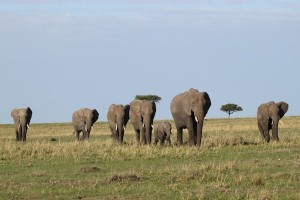
A family group walks toward us on the Maasai Mara in southwestern Kenya. On the Maasai Mara, we watched game on the Maasai Mara National Reserve as well as the adjacent Transmara and the Olare Motorogi conservancies.
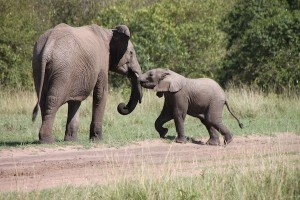
This mother-and-child pair seen in real life on the Maasai Mara were better than any YouTube clip. The youngster tried vigorously to engage his mother in play. He then entertained himself by walking a few steps forward, then walking backwards, then repeating the process a few times.
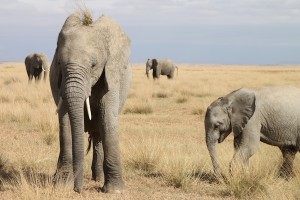
The juvenile at left, seen on the Kitirua Conservancy, entertained himself by tossing grass onto his head, where some of that grass remained.

A toddler, seen on the Maasai Mara, nurses with one foot lifted off the ground as if he were about to dance. Our guide said the lifted foot indicates contentment.
For more about Kenya, we offer at BestTripChoices.com the following, under the headline: Of movies, and animals on the move https://besttripchoices.com/international-countries/kenya/
This blog and photos are by Nadine Godwin, BestTripChoices.com editorial director and contributor to the trade newspaper, Travel Weekly. She also is the author of “Travia: The Ultimate Book of Travel Trivia.”

